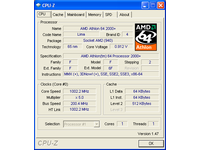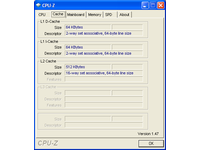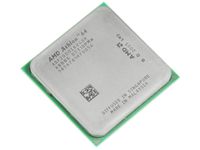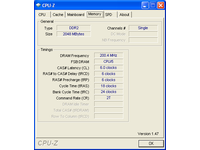Atom, Athlon, or Nano? Energy-Savers Compared
AMD Athlon 64 2000+
We’ll start with the low-power Athlon 64 sample we received a while ago. This processor is not available on AMD’s desktop CPU filter or on the product page on the Athlon 64 family. And we did not receive it through AMD’s official sampling process, either. It seems to be a part that AMD is capable of building, so we assume that customers will probably be able to procure the device in large quantities.
The processor is a single-core Athlon 64 CPU based on the 65-nm Lima core, which means that it has 512 KB L2 cache and all of AMD’s current processor features such as Cool’n’Quiet (which isn’t really necessary, here), Presidio, and the AMD-V virtualization technology. It does not come with additional functions such as a random number generator or an on-die encryption unit like VIA’s Nano does, but since it is a full-blown desktop processor, it should deal well with low to medium workloads.
Since it is a socket AM2 device, the processor can be used with most socket AM2 motherboards, whether you select a mainstream Micro-ATX board or customized, highly integrated form factors. Due to the large 940-pin socket, it cannot be used for ultra-compact solutions based on full-size processor packages and sockets.
8 W Athlon Power Rating
The low-TDP rating of 8 W still seems to be hard to reach for a 2.2 to 2.4 GHz processor with 122-million transistors that has been rated at a 45 W TDP. Our sample was limited to a maximum clock speed of 1000 MHz, which explains how AMD manages to stay within this small power envelope. We collected all the existing power ratings, which you’ll find on the processors’ imprint.
| ADV | 89 Watt |
| ADA | 89 Watt |
| ADO | 65 Watt |
| ADN | 62 Watt |
| ADH | 45 Watt |
| ADV | 89 Watt |
| ADD | 35 Watt |
| ADF | 8 Watt* |
* not available in mainstream
Fanless Operation Possible!
Get Tom's Hardware's best news and in-depth reviews, straight to your inbox.
The processor worked flawlessly in our test system, which was a Gigabyte MA78GM based on AMD’s 780G chipset. This is one of the most power-efficient commercially available desktop platforms, and it’s also suitable for low-power PC solutions. We found that BIOS did not report the memory speed correctly—while DDR2-800 speed was reported correctly, the actual memory clock according to the CPU-Z data was DDR2-400. Due to the low CPU clock only DDR2-400 is possible, DDR2-800 needs 2 GHz at least.
We decided to remove the fan from the standard cooler and give it a try, since an 8 W thermal design power can typically be dissipated by a heat sink without any fan as long as there is airflow in the system. And it worked—we were able to run all the benchmarks with a completely passively-cooled system after several hours of testing, so we could be sure that no clock speed throttling is happening due to overheating.
Good Performance, Average Efficiency
This system’s performance was acceptable, but it finished second or last in the benchmark runs, which lead to the third position in the performance-per-watt test using SYSmark 2004. The 1,000 MHz Athlon 64 2000+ cannot keep the pace as shown by the two competitors when it comes to compressing files, running SYSmark 2004, or running through the Cinebench test. It finished second in Lame and iTunes when we had the processors transcode audio.


Current page: AMD Athlon 64 2000+
Prev Page Which Is The Best Low-Power Platform? Next Page AMD Platform: Gigabyte MA78GM w/ AMD 780G Chipset

